#pictorialist landscape
Text
Adolf de Meyer · Japan 1900

Adolf de Meyer (1868–1946) ~ [Kofukuji Temple, Nara, Japan], 1900. Gelatin silver print | src The Met
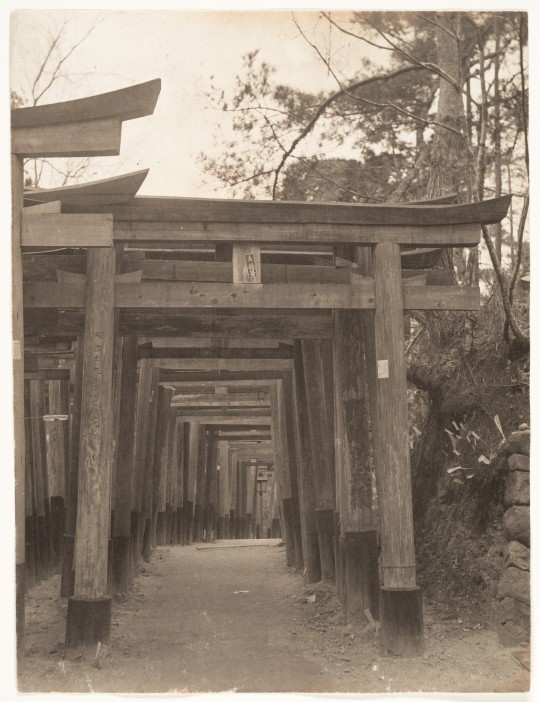
Adolf de Meyer (1868–1946) ~ Torii Gate at Lakeside, Japan, 1900. Gelatin silver print | src The Met
view more on wordPress

Adolf de Meyer (1868–1946) ~ [Golden Pavilion, Kyoto, Japan], 1900. Gelatin silver print | src The Met
view more on wordPress
#Adolf de Meyer#japan#landscape#pictorialism#paysage#torii#panorama#paisaje#paisatge#Landschaft#pictorial landscape#1900#pictorialisme#pictorialismo#torii gate#1900s#paesaggio#Piktorialismus#Piktorialismi#pictorialist landscape#Baron Adolf de Meyer#Adolph de Meyer
61 notes
·
View notes
Text

Bohdan Kopecký (Czech Artist , born in 1928) Josef Sudek photographs Prague, 1950.
Josef Sudek (1896-1976) was born in the Czech Republic. Originally a bookbinder, he was badly injured during World War I, resulting in a partial amputation of his right arm (that's why he needed assistance with his activities, and after World War II, he hired an assistant, Sonja Bullaty, a young Czech Jew who survived the Nazi concentration camps. It was Bullaty who took Sudek's work outside the Iron Curtain and preserved over 300 selections of his prints that he continued to send to her after she emigrated to America... And yes, she's the girl in the photo.)
In the 1920's he studied photography for two years in Prague under Jaromir Funke and worked primarily in the Pictorialist style. Eventually a local camera club expelled him for arguing about the need to move forward from "Painterly" photography and he then founded the progressive "Czech Photographic Society" in 1924. During and after World War II, Sudek created haunting night-scapes and panoramas of Prague, photographed the wooded landscape of Bohemia, and the window-glass that led to his garden (the famous "The Window of My Atelier" Series.")
Sudek's individualism did not fit in with the new post-war Czech Socialist Republic (Sudek never married, and was a shy, introverted person. He never appeared at his exhibit openings and few people appear in his photographs. Also notable is the fact that despite the privations of the war and Communism, he kept a renowned record collection of classical music) but the strong artistic tradition of the country meant that there were many who supported his work. He was the first photographer to be honored by the Republic with the title of "Artist of Merit" and in his 70th year, his life's work was recognized by the "Order of Labor."
61 notes
·
View notes
Photo


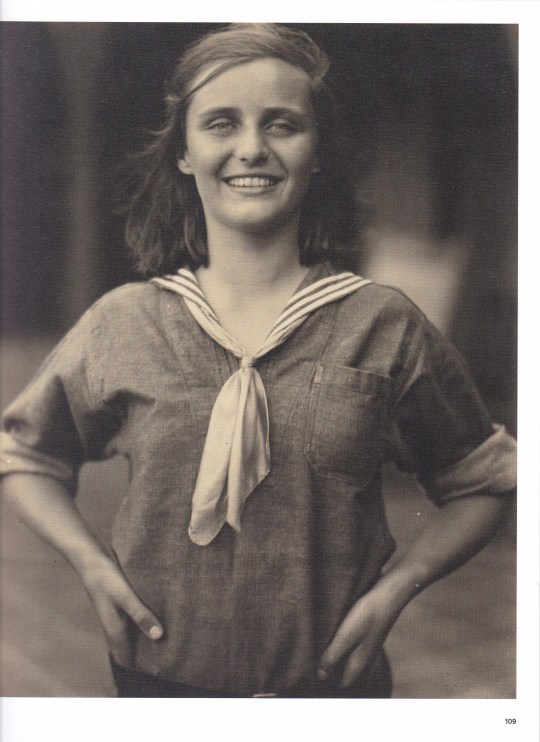
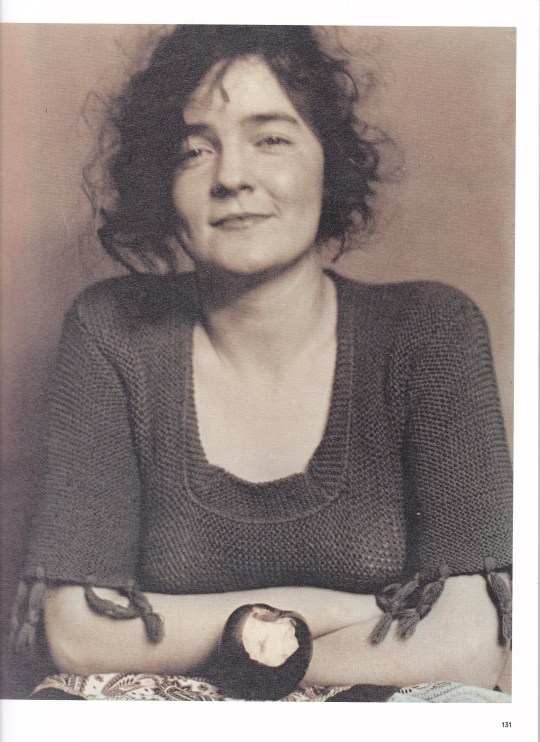

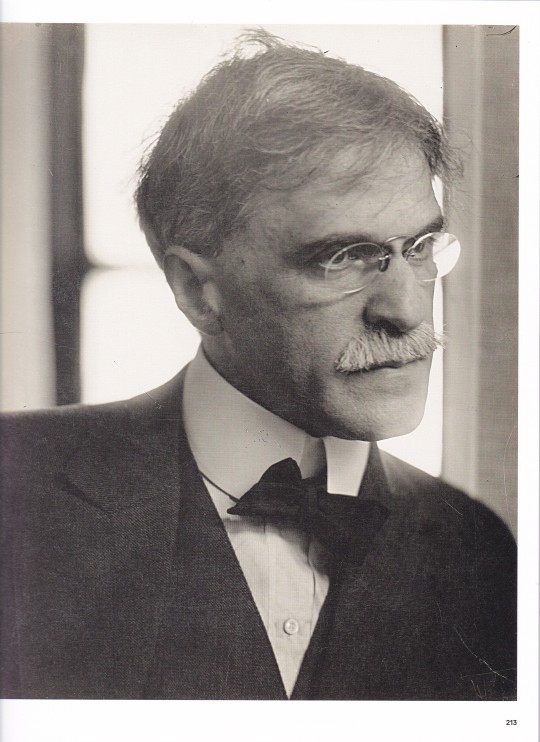


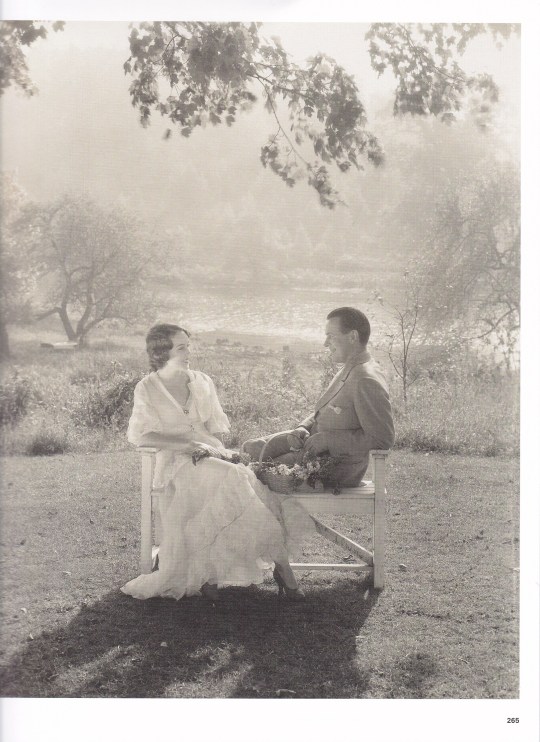

Edward Steichen The Luxembourg Bequest
a cura di Michel Polfer and Gilles Zeimet
SilvanaEditoriale, Cinisello Balsamo 2022, 464 pagine, 540 ill., cartonato, Inglese, 24,50 x 30 cm, ISBN 9788836651559
euro 60,00
email if you want to buy [email protected]
In March 1985, the National Museum of Luxembourg unexpectedly received a generous bequest from the estate of Edward Steichen, the Luxembourg-born and world-renowned American photographer. The bequest comprises a total of 178 prints, including 175 photographs by Steichen himself that cover almost all aspects of his photographic oeuvre – from the pictorialist images of his early years to portraiture, fashion, advertising, landscapes, and family photographs.
For the first time, this extraordinary collection is presented in a comprehensive scholarly manner, with full-page illustrations of all 178 photographs. In addition, the publication includes six new essays by five authors that deal with questions of identification, techniques, and dating of the prints as well as their conservation and preservation. They examine the provenance and impact history of the collection and compare the significance of the Luxembourg donation with other bequests made at the same time to institutions in the United States and overseas. The significance of the astonishingly large number of family photographs in the Luxembourg bequest and Steichen’s special role as a mediator of Modernism between Europe and the New World are also explored.
26/04/23
orders to: [email protected]
ordini a: [email protected]
twitter: fashionbooksmilano
instagram: fashionbooksmilano, designbooksmilano tumblr: fashionbooksmilano, designbooksmilano
#Edward Steichen#The Luxembourg Bequest#photography books#178 photographs#Modernism#American photographer#fashion books#fashionbooksmilano
16 notes
·
View notes
Text
Leonard Misonne (1870 – 1943) was a Belgian photographer.
Misonne was a master pictorialist photographer, whose atmospheric landscapes and street scenes are among the finest pictorial depictions of such subject matter.
He achieved his painterly photographs through alternative processing methods. He called his signature technique “mediobrome,” which combined bromide and oil printing.
“The sky is the key to the landscape.” –

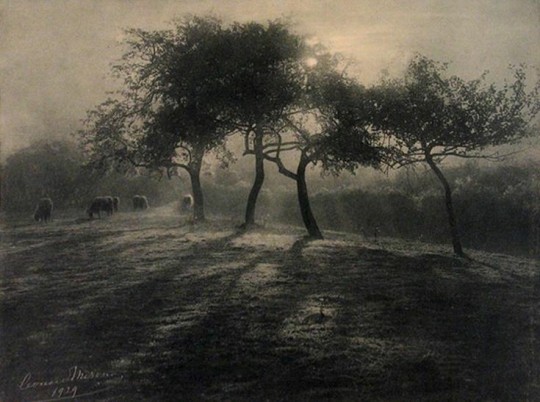

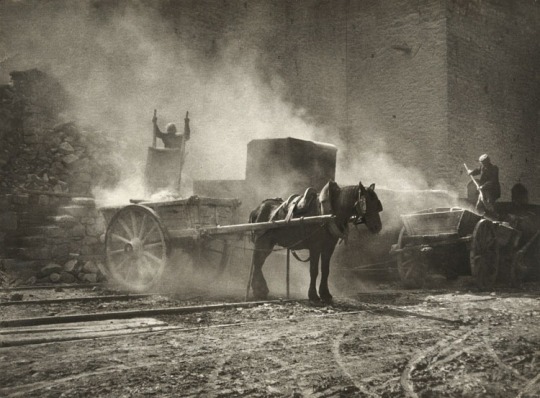


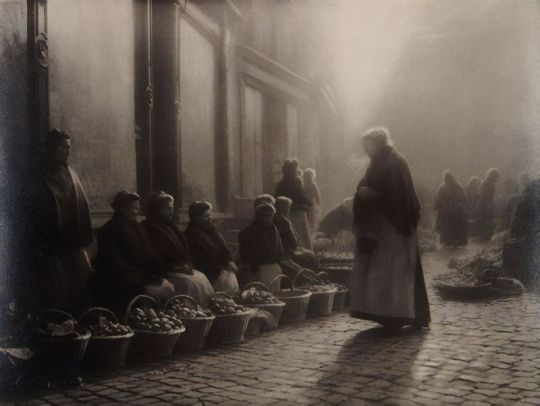



11 notes
·
View notes
Text

generativeart #ai #field #digitalart #mood #streetstyle #landscape_lovers #feeling #landscape #myst #ontheroad #moody #monocromatico #fineart #abandoned #monochrome #mexicanartist #myst #artgallery #dedaturated #digitalart #road #fog #loneliness #pasteltones #selectivefocus #artgalleries #pictorialism #pictorialists #poetic
3 notes
·
View notes
Photo
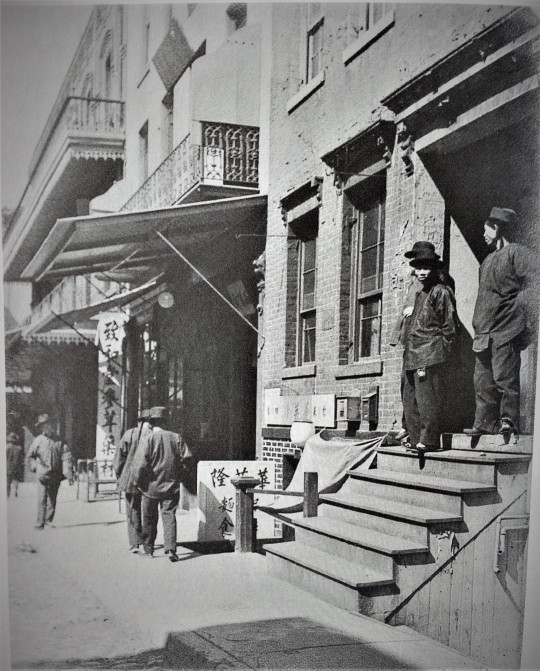
Untitled Chinatown street, c. 1898. (Photograph by Oscar Maurer (from the collection of the Oakland Museum of California, Museum Income Purchase Fund). The men seen in Maurer’s photo are standing on the landing of the stairs to 116 – 118 Waverly Place. Occupying a lot on the east side of the small street (and across from the Tin How temple and the headquarters and shrine of the Ning Yung district association), the building served as a boarding house.
Locating Oscar Mauer on Waverly Place (with a little help from D.H. Wulzen and the Goldsmith Bros.)
The Great Earthquake and Fire of 1906 obliterated San Francisco Chinatown so thoroughly that identifying the subject matter depicted by the scant photographic record of the community necessarily relies on chance and coincidence, and it often ends in futility. Not surprisingly, the untitled photo by Oscar Maurer taken in the late 1890s has eluded clarification by researchers of old Chinatown for decades.
Maurer migrated from his native New York City to study at the University of California at Berkeley and thereafter opened a photography studio in San Francisco. According to the Getty Museum, he became an associate member of Alfred Stieglitz's Photo-Secession and the first California-based photographer to achieve national prominence. “The only entrant from California in the first Chicago Camera Club Salon of 1900, Maurer received critical acclaim for his atmospheric landscape photograph The Storm. Encouraged by this success, he helped establish the first San Francisco Salon, held at the Mark Hopkins Institute of Art in 1901. Maurer regularly contributed his Pictorialist landscape photographs to Camera Craft, the journal of the California Camera Club, and to Camera Work, Stieglitz's influential publication.
As was the case of most of his fellow photographers in San Francisco (such as his colleague and collaborator, Arnold Genthe), Maurer lost his studio and its contents in the earthquake and fire. Although he reopened his studio in Berkeley, where he remained for the rest of his life, his photographs of old Chinatown remain very rare.
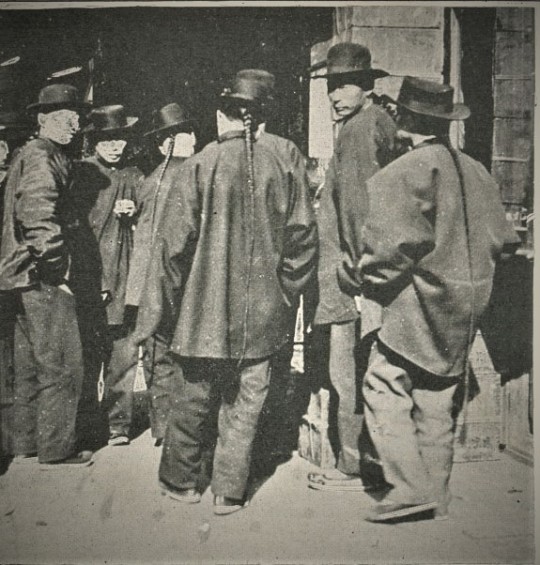
“Group of Highbinders Discussion a Late Proclamation, c. 1900. Photograph by Oscar Maurer (from the collection of the Bancroft Library).

“San Francisco, 1906” Photograph by Oscar Maurer (from the collection of the Oakland Museum of California)

“San Francisco, 1906” Photograph by Oscar Maurer (courtesy of John Aronovici)
Fortunately for the researchers of old Chinatown, Maurer captured two crucial pieces of signage in his 1898 photograph that help in identifying the precise location in Chinatown of the buildings. The first example can be seen in the vertical sign appearing at the left of the frame, containing the characters 致和堂參茸藥材 (lit.: “Gee Wo Ginseng Medicinal Herbs;” canto: “gee wo tong sum yung yeuk choy;” pinyin: “Zhì hé táng cān rōng yàocái”). The Horn Hong & co. Chinese business directory and lunar calendar for 1892 shows the Gee Wo Tong company located at 124 Waverly Place.

Detail from the Horn Hong & Co. Chinese directory for 1892 for the Gee Wong Tong company.
By the publication of the 1895 Langley directory the Gee Tau Hong & Co. and Gee Wo Tong & Co. shared the premises at 124 Waverly Place. The 1905 Sanborn map for this Chinatown street confirmed the presence of, and use of the property by, the Chinese herbalists. Having established the street on which the herbalists operated, the location of the basement eatery whose entrance signage can be seen in the center can be located with equal precision.
Moreover, by comparing Maurer’s photo with one by D.H. Wulzen of the same basement entrance, the full tradename of the eatery can be discerned as “Wah Ying Lung” 華英隆(canto: “wah ying loong”), a name which could also constitute literal shorthand for Chinese/English (or Chinese American). When viewed together, Mauer’s photo corroborates the partially-obscured address plate in the Wulzen photo as located at 120 Waverly Place.
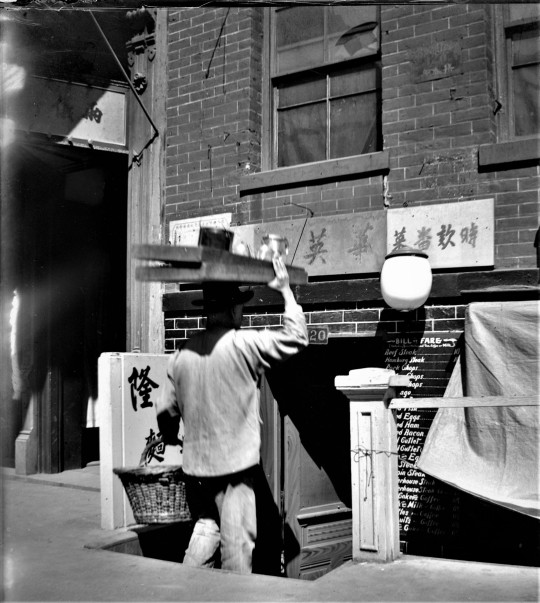
Restaurant worker returning from a delivery to a basement eatery, c. 1900. Photograph by D. H. Wulzen (from the D.H. Wulzen Glass Plate Negative Collection (Sfp 40), San Francisco History Center, San Francisco Public Library). The last two digits of the address at 120 Waverly Place can be seen over the door to the basement entrance. The right portion of the sign advertises literally seasonal, i.e., 時款 (canto: “see foon”) food.
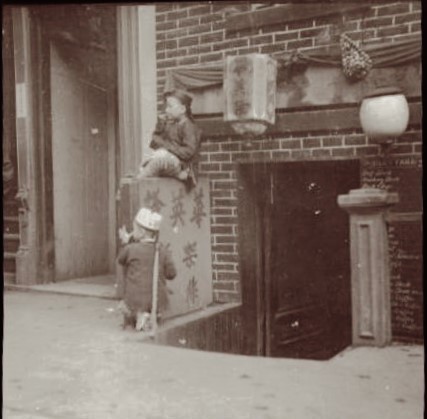
Two boys play near the sign of the basement eatery “Wah Ying Lung” 華英隆(canto: “wah ying loong”), c. pre-1900. Photograph by the Goldsmith Bros. (from a private collection).
Having established the address of the Wah Ying basement eatery at 120 Waverly Place, the men seen in Maurer’s photo are standing on the landing of the stairs to 116 – 118 Waverly Place. Occupying a lot on the east side of the small street, and across from the Tin How temple and the headquarters and shrine of the Ning Yung district association, the building served as a boarding house. The 1905 Sanborn map confirmed its use as “lodgings.”
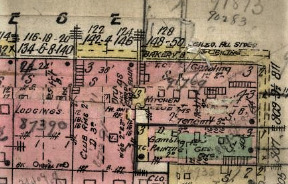
Detail showing Waverly Place in San Francisco Chinatown from the 1905 Sanborn Insurance Map (Vol. 1, Page 39-40) of San Francisco, prepared by the Sanborn-Perris Map Company, Limited, of New York.
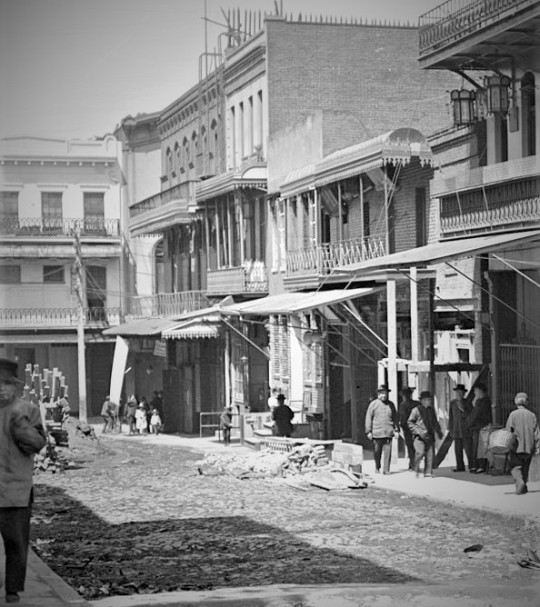
A detail from “Waverly Place - April 9, 1900” Photograph by D. H. Wulzen (from the D. H. Wulzen Glass Plate Negative Collection (Sfp 40), San Francisco History Center, San Francisco Public Library). This close-up looks north on Waverly Place from the intersection with Clay Street. Magnification of the center portion of the image shows the building elevation, the partial signage for the basement entrance to the Wah Ying eatery, and the stairs on which the trio of Chinese men stood for Oscar Maurer’s photo.
Thanks to the photographers of pre-1906 Chinatown such as Oscar Maurer, D.H. Wulzen, and the Goldsmith brothers, determined researchers can view the visual legacy of the Pictorialists and expand the public’s understanding of the gone world of old Chinatown.
[updated 2024-3-11]
#Oscar Maurer#Waverly Place#Gee Wo Tong & Co.#Wah Ying restaurant#D.H. Wulzen#Horn Hong & Co.#Goldsmith Bros.
4 notes
·
View notes
Text
[Disclaimer: this is a bunch of art history facts and tidbits masquerading as Midnight Pals fanfiction. I am so bored. Midnight Pals is by @bitterkarella , it's very good and you should read/listen. hello good day and I am so sorry]
Nièpce: Uhm. Bonjour. I would like to introduce you you all this new thing I made called a heliograph?
Caravaggio: who the fuck invited the chemist.
Hopper (looking at the heliograph): I like it. It reflects the tristesse and pointlessness of the world.
Genteleschi (talking over Hopper,to Caravaggio): who the fuck invited you.
Stieglitz: I like it and I'll argue your case but you must NEVER bring up the word "Kodak"
(A cartoonish brawl breaks out in the background)
Nièpce: What's a Kodak?
(scene)
Turner: I would like to introduce to you my painting Snow Storm – Steam-Boat off a Harbour's Mouth Making Signals in Shallow Water, and going by the Lead. The Author was in this Storm on the Night the "Ariel" left Harwich
(Everybody looks at the painting)
Hopper: but what's the painting called.
Turner (sarcastically): it was called many things by the critics.
Turner:...
Turner: you can call it snowstorm.
(scene)
Duchamp: I would like to introduce you to my painting "Nude descending a staircase"....
Gauguin (startling out of deep sleep): Tits??
Gauguin (squinting at the painting): .....
Gauguin: go fuck yourself Marcel.
Genteleschi (nursing a stab wound from the earlier fight) That's what you should do, then you'd stop making women sick.
(murmurs of agreement)
(scene)
Dramatis personae:
Nicephore Nièpce, an early pioneer of photography (his heliograph is today regarded the first photograph ever)
Alfred Stieglitz: American photographer, part of the pictorialist movement that heavily pushed the "photography is a form of art too damn it" angle after the Eastman Kodak company released the first commercially viable photo camera and photography went from a totally obscure nerd hobby that only a few people could even pull off to something that everyone could easily do.
Caravaggio: Renaissance painter. Most of the information that exists on him are court records of his stab-happy crime spree and that he once sued a guy for painting in his style which is a 21st century dick move. He got thrown out of two different cities for the crime of stabbing a guy fatally in the balls. This is really all you need to know about Caravaggio.
Artemisia Genteleschi, renaissance WOMAN and absolute badass. There were woman artists back then but not many and she could already paint at a professional level at age fifteen or sixteen! She got admitted to the academy of arts!! She sold her paintings internationally! She was really really good.
Edward Hopper, member of the school of so called "American realism" and probably clinically depressed according to my classmate who did the presentation on him. If it looks sorta realistic and exudes a sense of isolation and loneliness even if there is multiple people in the painting, it's probably one of his. (He was part of last year's art history final and I thank whoever looks kindly on highschoolers that I was able to retain some information from that presentation as well as.my classmate for picking him off the list)
William James Mallord Turner
British landscape painter. Regarded as Britain's Favorite painter (these days)
He was supposed to be the subject of my presentation but I begged my teacher to let me do Marcel Duchamp instead. I have since seen the errors of my way.(more on that later) Snowstorm is currently on loan to the Lenbachhaus, an art museum in Munich Germany, and I went to the exhibition and stood right in front of it. It's really something.
The things the critics said about Snowstorm were "soapsuds and whitewash" and "all of the contents of his (Turner's) pantry"
Now Turner had a certain "fuck off" attitude to artistic people pleasing but according to a contemporary source called John Ruskin (I think) he read that scathing review and went "soapsuds and whitewash! Soapsuds and whitewash! I wonder what they think the sea's like!? I wish they'd been in it!" which I think is hilarious.
And finally Marcel Duchamp.
What the fuck do I say about him? I have done the presentation. I got a 2 (that's pretty good!) And I still struggle to understand what the guy was even doing. His most well known contribution to art is an upside down toilet. Or well...a photo of that that was photographed by Stieglitz.
He was french I guess that's what I can say about him. I was like "oh he did Object art. I do object art. I'll like what he made" but it turns out that "object art" is a really vague catch-all term. :) who could've guessed. I like Tom Every more (look up the Evertron. It's the world's largest scrap metal sculpture and it is freaking phenomenal. THAT'S what I wanna do. Not Marcel Duchamp. I wanna make whimsical shit like he did or weird shit like Luise Bourgeois did. They're my art heroes. Not Marcel Duchamp. just wanted to make Gauguin look bad cause he was a thoroughly unpleasant person who I wouldn't touch with a six meter pole )
1 note
·
View note
Text
Research Numero UNO
Title: Capturing Timeless Moments: The Visionary Photography of Ansel Adams
Introduction:
In the vast realm of photography, there are few names as iconic and influential as Ansel Adams. Born on February 20, 1902, in San Francisco, Adams went on to become one of the most celebrated landscape photographers of the 20th century. His work not only showcased the breathtaking beauty of the American West but also revolutionized the art of black-and-white photography. In this blog post, we'll delve into the life and work of Ansel Adams, exploring the essence of his photographic vision through some of his most iconic images.
Early Life:
Ansel Adams developed an early passion for nature, spending much of his childhood exploring the rugged landscapes of Yosemite National Park. At the age of 14, he received his first camera during a family trip to Yosemite, sparking a lifelong love affair with photography. Adams began his formal photographic education in 1927, studying under the renowned photographer Fred Archer in San Francisco. His early work focused on the soft-focus, pictorialist style of the time.
Evolution of Style:
As Adams honed his craft, he transitioned from pictorialism to a more realistic, sharp-focus style. He embraced the emerging technical advancements in photography, particularly the Zone System—a method of controlling exposure and development to achieve a desired level of tonality. This shift marked the beginning of Adams' signature style, characterized by crisp details, rich contrasts, and deep shadows.
Iconic Works:
Moonrise, Hernandez, New Mexico (1941):
![Moonrise, Hernandez, New Mexico]
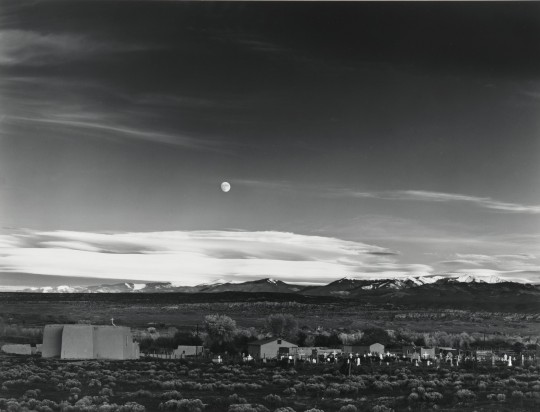
Perhaps Adams' most famous photograph, "Moonrise, Hernandez, New Mexico" captures the enchanting moment when the moon rises over a small village. The image is a testament to Adams' mastery of exposure and his ability to evoke a sense of mystery and grandeur.
Clearing Winter Storm, Yosemite National Park (1944):
![Clearing Winter Storm, Yosemite National Park]
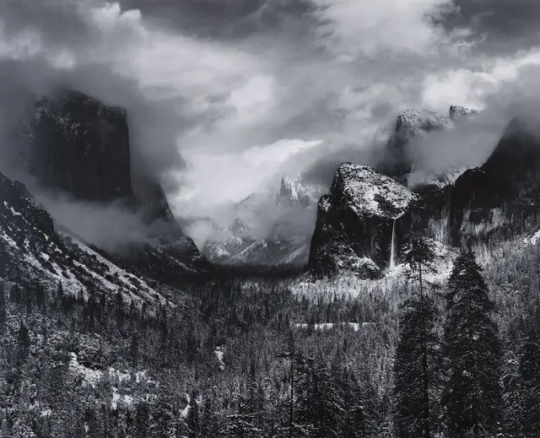
This photograph beautifully captures the interplay of light and shadow as a winter storm clears over Yosemite Valley. Adams' meticulous attention to detail and composition is evident, creating a mesmerizing scene that transports viewers to the heart of nature's beauty.
The Tetons and Snake River, Grand Teton National Park (1942):
![The Tetons and Snake River, Grand Teton National Park]

This iconic image showcases Adams' ability to convey the majesty of the American West. The composition, with the Snake River winding through the foreground and the Teton Range towering in the background, epitomizes Adams' commitment to capturing the sublime in nature.
Legacy:
Ansel Adams' influence on the realm of photography transcends the beauty captured in his remarkable images. His fervent commitment to environmental conservation is evident as he employed his art to instill a sense of appreciation and a call to protect the natural world. The enduring legacy of Adams is not solely confined to his captivating photographs; it is also embodied in institutions like the Ansel Adams Gallery and the Ansel Adams Wilderness, both established as tributes to his enduring contributions.
Conclusion:
The extensive collection of Ansel Adams' work serves as an ongoing wellspring of inspiration for both photographers and nature enthusiasts, reinforcing the profound ability of photography to capture the beauty and importance of our natural environment. With his unmatched technical expertise and steadfast commitment to his craft, Adams has imprinted an enduring legacy on the realm of photography, fundamentally influencing the manner in which we observe and value the landscapes enveloping us.
0 notes
Text

03 Works, RELIGIOUS ART - Contemporary 20th C. Interpretation of the Bible!, František Drtikol's Étude de la Crucifixion - #12
In 1910, Frantisek Drtikol opened his studio in Prague and rapidly developed a reputation as a portrait photographer. At first, his personal work - mostly landscapes - diffused a symbolist-like pictorialist aesthetic. In the 1920s, he created daring and inventive nude studies that mingled Cubism, Abstraction and Art Deco…
Please follow link for full post
Art,Paintings,Femme crucifiée,Helenic,biography,History,Religiont,mythology,Zaidan,František Drtikol,Contemporay RELIGIOUS ART,Crucifixion,footnotes,
Art #Bible #biography #History #Jesus #mythology #Paintings #religion #Saints #Zaidan #footnote #fineart #Calvary #Christ
#Art#Bible#biography#History#Jesus#mythology#Paintings#religion#Saints#Zaidan#footnote#fineart#Calvary#Christ
0 notes
Text
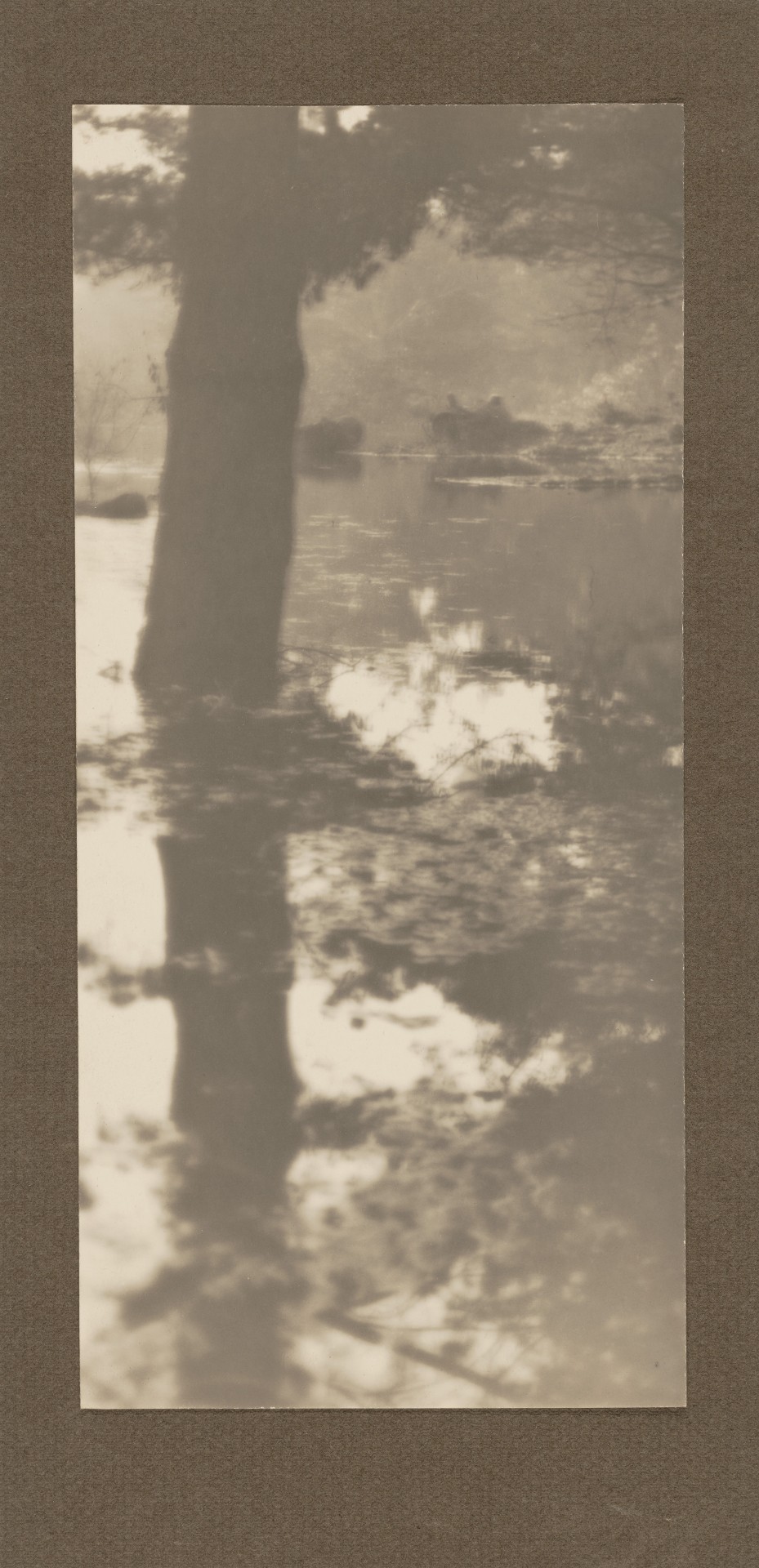
Taizo Kato (Japanese-American, 1887 - 1924) ~ Untitled, before 1924 | src Getty Museum
A tree growing beside a pond. The tree and its branches are reflected in the surface of the water.
#Taizo Kato#pictoralism#pictorial motive#pictorialist photographer#Japanese American#1920s#soft focus#landscape#waterscape#Piktorialismus#pictorialismo#pictorialisme#Japanese American pictorialists#foliage#pond#reflection
51 notes
·
View notes
Text
PH21 Gallery presents: Scene and Meaning: The Art of Photography @ Barcelona – A Curated International Photography Exhibition
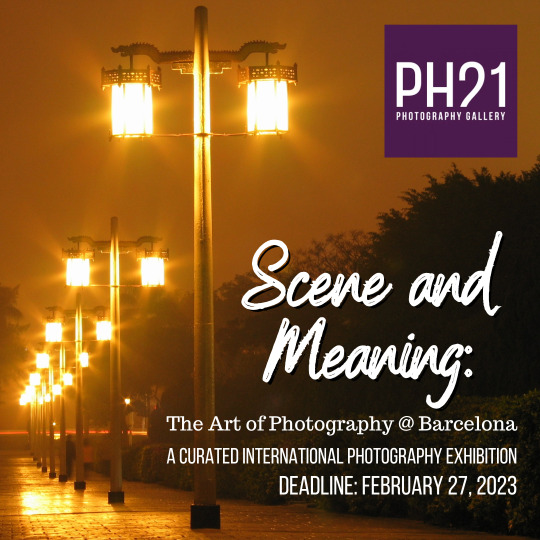
Although photography first emerged as a technological invention, it was also quickly conceived as an artistic practice as well. Pictorialist photographs in the nineteenth century were created to look like paintings, while advocates of straight photography in the first part of the twentieth century strived for the purely photographic means of creating photographic meaning. Street photographers devoted the medium to capturing the fleeting moment, while in the last part of the twentieth century many photographers turned to staging and directing to utilize photography for artistic visual communication. Straight photography creates photographic meaning from the scene observed, while directorial, staged photography creates a scene to be photographed from a preceding conception. Art photography also includes numerous genres and creative practices from portraiture, landscape and still life to abstract and conceptual photography. In this call we ask contemporary photographers to show how they understand photography as a fine art practice in the twenty first century. PH21 Gallery invites photographers to submit their work for a group exhibition themed Scene and Meaning: the art of photography. We are looking for submissions from all photographers who are interested in photography as an art form and would like to share their work with a wider international audience through the exposure of PH21 Gallery. The theme is broadly construed; all artistic photography genres are welcome.
DEADLINE: February 27, 2023
For more information: https://www.theartlist.com/ph21-gallery-presents-scene-and-meaning-the-art-of-photography-at-barcelona-a-curated-international-photography-exhibition
#art#art call#art exhibition#photography#photography exhibition#PH21 Gallery#The Art of Photography @ Barcelona#Curated International Photography Exhibition#Scene and Meaning#TheArtList
0 notes
Photo

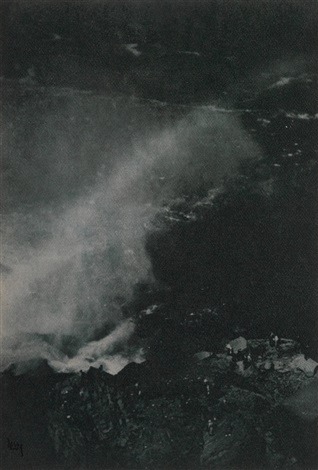

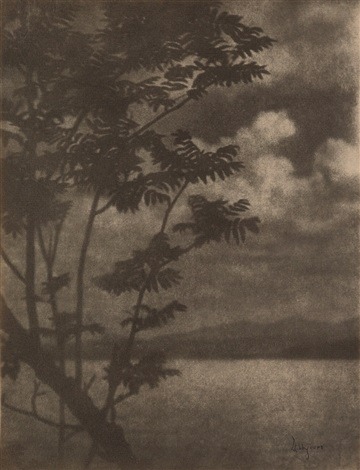
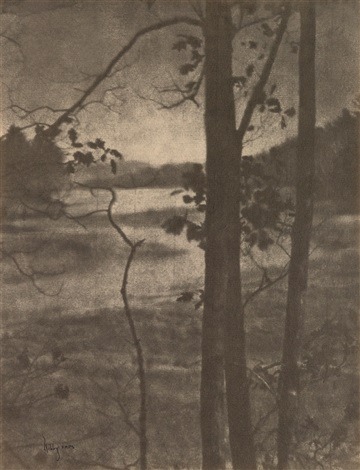

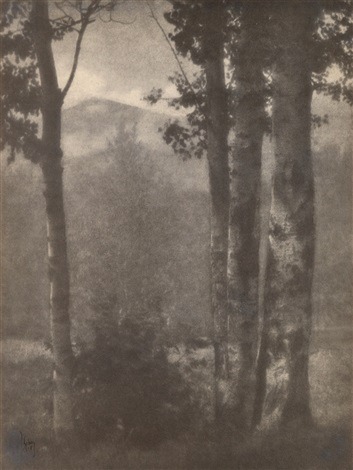
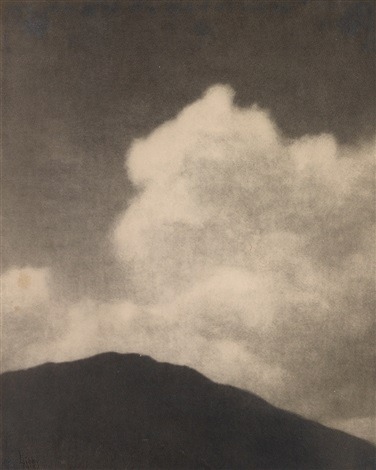
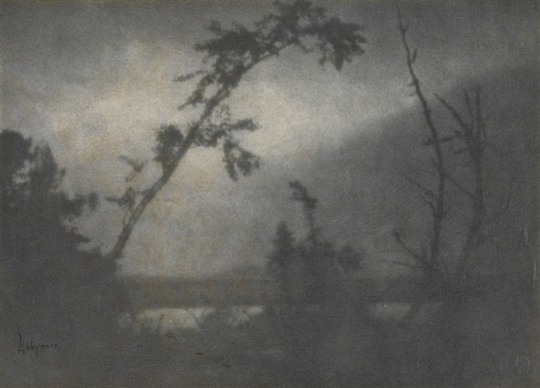
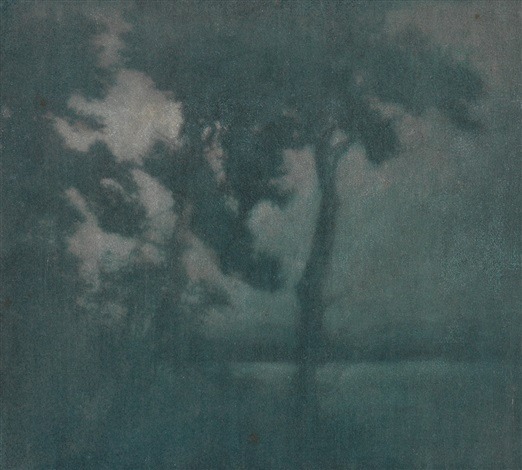
Francis Orville Libby - Group of 10 fascinating Pictorialist landscapes and seascapes of New England.
(Source: artnet.com)
#vintage photography#francis orville libby#gum bichromate prints#pictorialist landscapes#photographic printing#gum printing
25 notes
·
View notes
Photo

Forman G. Hanna, Striated rocks with fallen boulder, 1920. "Born on 1882 and raised in a small Texas town, Hanna had his first encounters with photography and most of his art training through camera-club magazines. Emulating the Pictorialist style, he used his western surroundings as subject matter. While working as a pharmacist in Globe, Arizona, Hanna made frequent trips to nearby canyons and Pueblo villages to photograph what the believed was a lost way of life. Recognized for his Arizona landscapes, he often exhibited in the juried shows of camera clubs. In the years just following World War I, these organizations provided an important forum for many of the nation’s artistic photgraphers like Hanna. Although they lived in dfferent parts of the country, these photographers attained a collective identity.." https://www.instagram.com/p/CHi1FiLAt2O/?igshid=145dlfaz4dptn
89 notes
·
View notes
Text

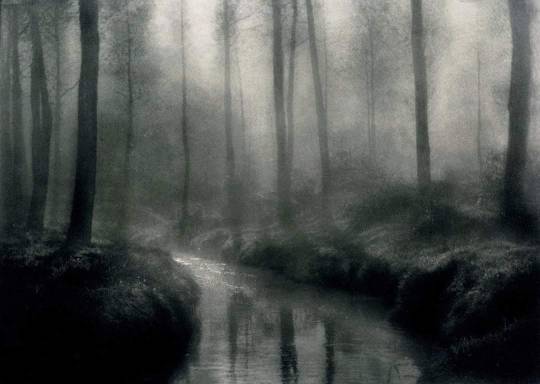
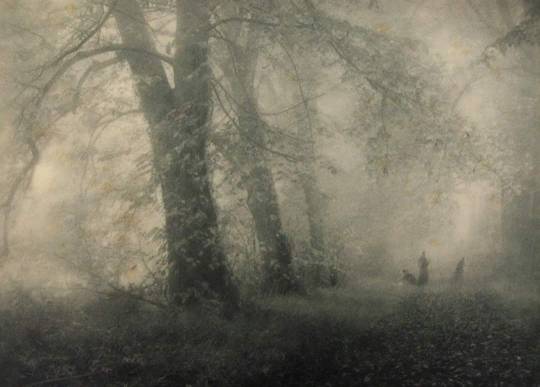
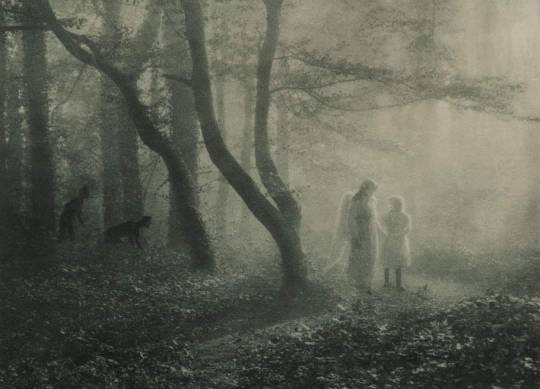
Léonard Misonne (1870 - 1943) was a Belgian pictorialist photographer. He is known for his landscapes and street scenes with atmospheric skies.
9 notes
·
View notes
Text
ANsel Adams
Ansel Adams
What group did Ansel Adams start? F/64
Why did he set up this group? He started the group to get photography accepted as a form of Fine Art
What type of photography is best known for? He is very well known for his Landscape and Sharp Detailed Photography
What did Ansel first train as? Ansel first trained as a musician.
When did his love for photography begin? On a Family Trip to Yosemite National Park in 1916
What was his first camera? A Kodak No. 1 Brownie Box
What age was Ansel when he had his first images published? Ansel was 19 years old
What type of techniques did start experimenting with? In the dark room, Pictorialist, edging and soft focus
How much did Ansel sell his first portfolio for? He sold his first portfolio for $4000
What Artists did Ansel meet whilst in New Mexico? Paul Strand, John Martin, Georgia O’Keeffe and
Who was a huge influence on Ansel? Paul Strand
Find out more about the artist that influenced Ansel Adams, can you see the influence of this artist on Ansel’s work? Paul Strand Began studying photography when he was 17 years old, you can see how Strand’s use of contrast has helped in influencing Ansel’s Landscape work.
Why was group F64 significant? F/64 helped the new Southern California School of Photography gain more attention.
What is Pictorialism? Pictorialism borrows techniques from other forms of art, it is also an international style and aesthetic that was common in the late 19th and early 20th centuries. It involves manipulating the image in the dark room using brush strokes or developing in a different colour such as brown
What age did Ansel open his first gallery? 31
What happened in a trip to Mexico in 1941? Ansel captured his most famous photograph, Moonsire Over Hernandez
How long was Ansel Adams career? His career was around 60 years
Along with Fred archer what did Ansel Adams pioneer? The Zone System
Research the system? What is it? Can it be applied to digital photography? The Zone System is a photographic technique for determining optimal film exposure and development and Yes it can
What was Ansel’s biggest selling image called. Moonrise Over Hernandez
What type of camera did Ansel mainly use? Hassleblad 500c Medium format.
Why did Ansel use a red filter? A red filter helped to give greater contrast by darkening the blues in the photographs.
Steichen and Stieglitz? Who are they and what are they known for? Both of them are American Photographers, Most known for helping make photography an accepted art form.
4 notes
·
View notes
Text
Pre-Production – Inspiration ANSEL ADAMS
What group did Ansel Adams start?
Ansel started a group called f/64
Why did he set up this group?
To try and get photography accepted as an art form
What type of photography is best known for?
landscape photography
What did Ansel first train as?
He first trained as a musician specifically a pianist
When did his love for photography begin?
His love for photography Begin during trips to Yosemite National Park
What was his first camera?
He first used a Kodak Brownie Box Camera, that was a gift from his father
What age was Ansel when he had his first images published?
he was 19
What type of techniques did start experimenting with?
pictorialist techniques, including etching, rum oil processes and soft focus
How much did Ansel sell his first portfolio for?
his portfolio of High Sierras for almost $4000
What Artists did Ansel meet whilst in New Mexico?
Georgia O’Keeffe, John Marin and Paul Strand
Who was a huge influence on Ansel?
Paul Strand
Find out more about the artist that influenced Ansel Adams, can you see the influence of this artist on Ansel’s work?
Paul Strand began studying photography when he was 17 years old, he helped to establish Photography as an art form in the 20th century
Why was group F64 significant?
it was significant to the advancement of photography, it proved a modern alternative to the Steichen Stieglitz camera clubs and opened attention to new Southern California school of photographers
Find the groups manifesto online What is Pictorialism?
Group f/64 displayed the following manifesto at their 1932 exhibit:
“The name of this Group is derived from a diaphragm number of the photographic lens. It signifies to a large extent the qualities of clearness and definition of the photographic image which is an important element in the work of members of this Group. The chief object of the Group is to present in frequent shows what it considers the best contemporary photography of the West; in addition to the showing of the work of its members, it will include prints from other photographers who evidence tendencies in their work similar to that of the Group. Group f/64 is not pretending to cover the entire spectrum of photography or to indicate through its selection of members any deprecating opinion of the photographers who are not included in its shows. There are great number of serious workers in photography whose style and technique does not relate to the metier of the Group. Group f/64 limits its members and invitational names to those workers who are striving to define photography as an art form by simple and direct presentation through purely photographic methods. The Group will show no work at any time that does not conform to its standards of pure photography. Pure photography is defined as possessing no qualities of technique, composition or idea, derivative of any other art form. The production of the "Pictorialist," on the other hand, indicates a devotion to principles of art which are directly related to painting and the graphic arts.The members of Group f/64 believe that photography, as an art form, must develop along lines defined by the actualities and limitations of the photographic medium, and must always remain independent of ideological conventions of art and aesthetics that are reminiscent of a period and culture antedating the growth of the medium itself.The Group will appreciate information regarding any serious work in photography that has escaped its attention, and is favorable towards establishing itself as a Forum of Modern Photography.”
What age did Ansel open his first gallery?
Ansel opened his first gallery in San Fransisco at age 31
What happened in a trip to Mexico in 1941?
The trip yielded one of Adams most famous photographs ‘Moonrise over Hernandez’
How long was Ansel Adams career?
His career lasted 60 years
Along with Fred archer what did Ansel Adams pioneer?
They pioneered the zone system, which is a technique to change light into formal measured densities for negatives and printing processes
Research the system? What is it? Can it be applied to digital photography?
The zone system was invented for film photography, it was used to reach the optimal exposure during the capturing of the image and the developing and printing of the negative
What was Ansel’s biggest selling image called. Show an example of this.
he made over $25 million from his photograph ‘Moonrise over Hernandez’
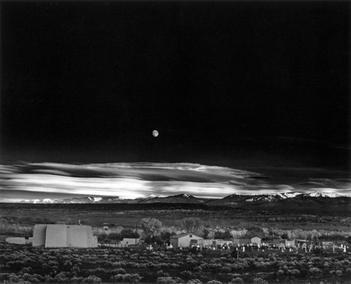
What type of camera did Ansel mainly use?
Deardorf 8x10 View Camera and a Hassleblad 500c Medium Format
Why did Ansel use a red filter?
Ansel used a red filter to transform the bright sky into a dark black
What typical technical camera settings would Ansel use and why?
He was able to adjust the film plane and the lens plane so that he could control the depth of field and the size relationships pf objects in the frame with tilt and rise and fall movements. Using this technique, he was able to alter the perspective to his desire
Steichen and Stieglitz? Who are they and what are they known for?
They were two of the three giants of photography, along with Strand. Their work was exhibited at The Metropolitan Museum of Art in New York from November 2010 - April 2011
2 notes
·
View notes